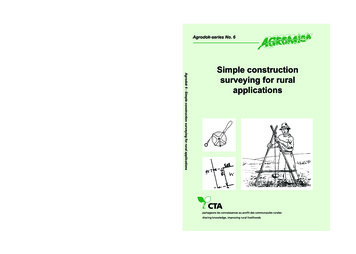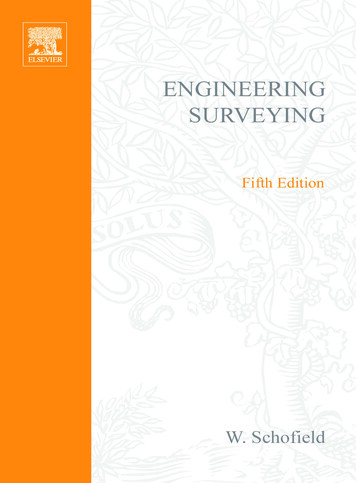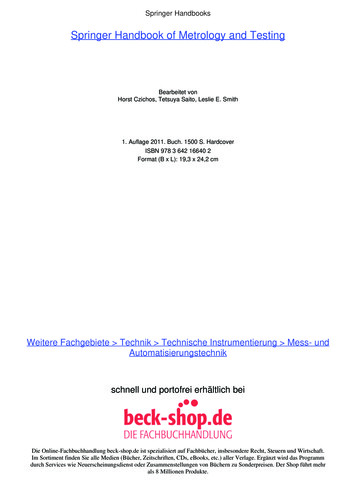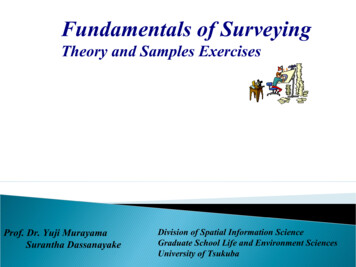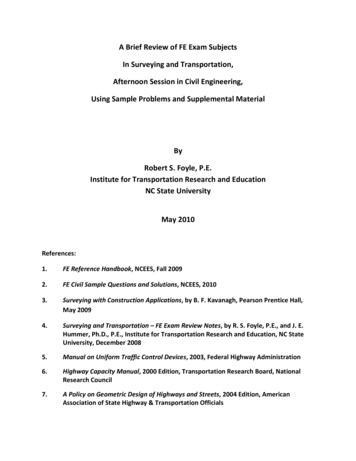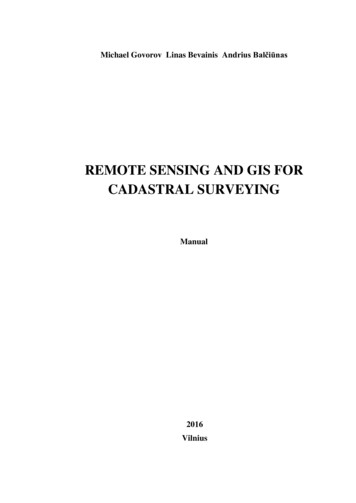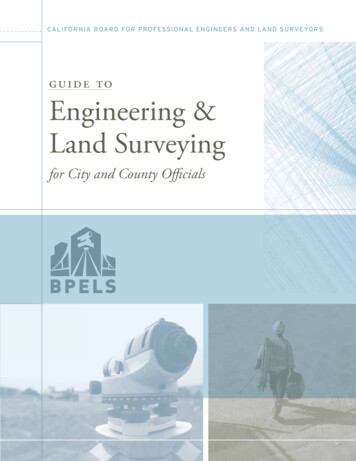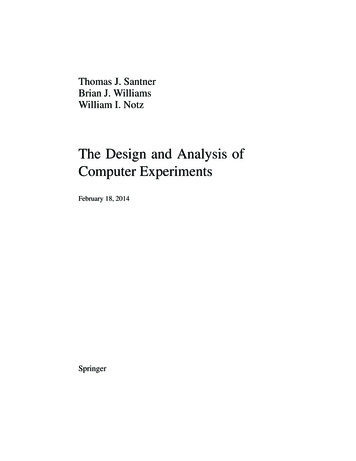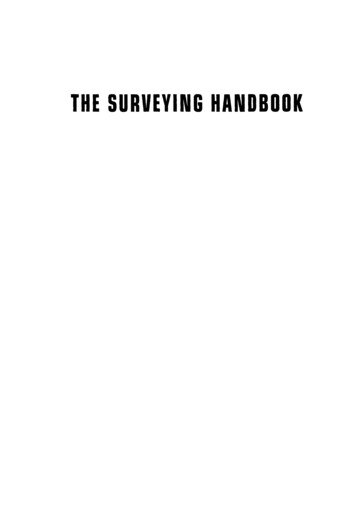
Transcription
THE SURVEYING HANDBOOK
THE SURVEYING HANDBOOKS E C O N D EDITIONedited by Russell C. Brinker and Roy MinnickSPRINGER-SCIENCE BUSINESS MEDIA, B.V.
Library of Congress Cataloging-in-PublicationThe surveying handbook/editors, Russell C. Brinker and Roy Minnick--2nd ed.cm.p.Includes bibliographical references and index.ISBN 978-1-4613-5858-9ISBN 978-1-4615-2067-2 (eBook)DOI 10.1007/978-1-4615-2067-21. Surveying. I. Brinker, Russell C. (Russell Charles). IL Minnick, Roy.TA555.8871994526.9--dc2091-5241CIPBritish Library Cataloguing in Publication Data availableCopyright 1995 by Springer Science Business Media DordrechtOriginally published by Chapman & Hall in 1995Softcover reprint of the hardcover 2nd edition 1995All rights reserved. No part of this publication may be reproduced, stored in a retrievalsystem or transmitted in any form or by any means, mechanical, photo-copying, recording,or otherwise, without the prior written permission of the publisher, Springer-Science Business Media, B.V.Printed on acid-free paper.
ContentsPreface1Preface to the First EditionxxzxContributorsxxxiSurveying Profession, Registration, and AssociationsWalter G. veIViewThe FutureBackground of Surveying and MappingThe SUIVeying ProfessionSUIVeying LiteratureSUIVeying Education11111222Surveying Field Notes, Data CollectorsRussell C. ortance of Field NotesEssentials of Superior NotesField BooksTypes and Styles of NotesAutomatic RecordingNotekeeping PointersAdditional Basic Noteforms5571112v
viContents3 Measurement Errors20Bro. B. Austin Barry, onReadingsRepeated ReadingsBest ValueAccuracy and PrecisionErrors in MeasurementSystematic ErrorsAccidental ErrorsErrors Versus VariationsDistribution of Accidental ErrorsStandard DeviationUses of Standard DeviationVariance and Standard DeviationUse of Standard Specifications for ProcedureDistribution of Accidental ErrorsPlotting the Normal Probability CurveMeaning of Standard DeviationMeaning of Standard ErrorPlotting the Normal Distribution in Other FormsPropagation of Accidental Errors3-20-1 Addition3-20-2 Subtraction3-20-3 Multiplication3-20-4 Division3-20-5 Other OperationsArea of a TraverseErrors and WeightsCorrectionsSignificant Figures in Measurements3-24-1 Exact Versus Doubtful Figures3-24-2 Use of Zero3-24-3 Rules of Thimb for Significant Figures3-24-4 Rounding Off3-24-5 Using Exact Values4 Linear MeasurementsKmneth S. Curtis4-14-24-3IntroductionUnits of Linear MeasurementDirect Comparison Distance-Measurement Methods4-3-1 Pacing4-3-2 Odeometer of Measuring Wheel4-3-3 Folding Rules and Hardware Tapes4-3-4 Woven or Fiberglass Tapes4-3-5 Steel and Invar Tapes4-3-6 Taping 3343435353536363840404040404142424244444445454648
Contents4-44-3-7 Taping Procedures4-3-8 Taping over Level Ground4-3-9 Horizontal Taping on Sloping or Uneven Ground4-3-10 Slope Taping4-3-11 Dynamic Taping4-2-12 Systematic Errors in TapingOptical Distance-Measurement Methods4-4-1 General Introduction4-4-2 Stadia Tacheometry4-4-3 Stadia Reduction Devices4-4-4 Accuracy of Stadia Measurements4-4-5 Diagram Tacheometers4-4-6 Plane table Alidades4-4-7 Optical Wedge Attachments4-4-8 Double-Image Tacheometers4-4-9 Subtense Tacheometry4-4-10 Tangential Tacheometry4-4-11 Rangefinders5 Linear Measurements: EDM 67PUTter W. uctionPrinciplesThe Application of ModulationThe Index of Refraction of AirDecade Modulation TechniqueEnvironmental CorrectionLight Beam Versus MicrowaveInstrumental and Reflector ErrorsSlope CorrectionAccuracy SpecificationsTotal-Station Instruments6 Angle Measurements: Transits and TheodolitesEdward C. ar DefinitionUnits of Angular MeasurementBearings and Azimuths6-4-1 Bearings6-4-2 AzimuthsOperational Horizontal AnglesHistory and Definition of Surveyor's Transit and TheodoliteAngle-Distance RelationshipTransit6-8-1 Surveyor's Transit6-8-2 Telescope6-8-3 Upper 78788
Contentsviii6-8-4 Lower 8-136-8-146-8-156-9Leveling HeadThe CompassTripodGraduated CirclesVerniersTransit OperationInstrument SetupMeasuring a Horizontal Angle with a TransitLaying out a Horizontal Angle with the TransitMeasuring Horizontal Angles by RepetitionLaying Out Angles by Repetition -16 Extending a Straight Line -17 Establishing Line Beyond an Obstruction6-8-18 Wiggling in6-8-19 Vertical Angles6-8-20 Sources of ErrorOptical Theodolites6-9-1 Descriptions6-9-2 Repeating Theodolites6-9-3 Directional Theodolites6-9-4 Electronic Theodolites6-9-5 Theodolite Setup6-9-6 Horizontal Angles with Directional Instruments6-9-7 Zenith Angles with a Theodolite6-9-8 Horizontal Angle Layout by Directional Theodolites6-9-9 Forced Centering6-9-10 Expected Accuracy of 31031031051071081081091111111127 23124125125126RDbert J. SchultzIntroductionDefinitionsDirect LevelingProcedures in Differential LevelingTrigonometric LevelingEarth Shape ConsiderationsIndirect LevelingOther Leveling ProceduresInstrumentationHand LevelLeveling VialsEngineer's LevelsThe Dumpy LevelFirst-Order LevelsLeveling RodsNoteforms
27Profile LevelingPrecise LevelingProfiles in Highway DesignLeveling for Water and Sewer DesignEarthwork QuantitiesMappingErrorsSystematic Errors and AdjustmentsSpecificationsPrecise TheoriesGeoidal Height8 Instrument AdjustmentsGerald W. ions for AdjustmentBreakdown of AdjustmentsGeneral DefinitionsAcljustment of Levels8-5-1 Dumpy Level: General Information8-5-2 Dumpy Level: Principal Adjustments8-5-3 Wye Level: General Information8-5-4 Wye Level: Principal Adjustments8-5-5 Automatic Level: General Information8-5-6 Automatic Level: Preliminary Adjustments8-5-7 Automatic Level: Principal Adjustments8-5-8 Tilting Level: General Information8-5-9 Tilting Level: Principal AdjustmentsAdjustments of Transits and Theodolites8- 1 Transit: General Information8- 2 Transit: Principal Adjustments8- 3 Theodolite: General Information8-M Theodolite: Principal AdjustmentsOther Surveying Equipment8-7-1 Tribrach8-7-2 Rod Level8-7-3 Striding Level8-7-4 TripodCleaning EquipmentShipping Equipment9 52153154154154154154155155156Jack B. Evett9-19-29-3IntroductionField Measurements in TraversingAngle Misclosure and Balancing156158159
xContents9-49-59-69-79-8Traverse Misdosure and Balancing9-4-1 Latitudes and Departures9-4-2 Traverse BalancingRectangular CoordinatesMissing DataArea Computations9-7-1 DMDMethod9-7-2 Coordinate Method9-7-4 Area by PlanimeterProgrammed Traverse Computations10 Survey DraftingEdward G. 10-11IntroductionSurvey DrawingsMap ScaleMap DraftingDatums for MappingTopographic MapsTopographic Map Construction10-7-1Plotting Control10-7-2 Drafting Machine10-7-3 Protractor10-7-4 Coordinates10-7-5 Alternate Methods of Plotting Angles10-7-6 Plotting Details10-7-7 Characteristics of Contours10-7-8 Plotting Contours10-7-9 Drawing Contours by Interpolation10-7-10 Topographic licenseConstruction MapsEarthwork Cross Sections10-8-110-8-2 Plan and Profile Maps10-8-3 Site or Grading Plans10-8-4 As-Built MapsBoundary MapsSubdivision Maps10-9-110-9-2 Parcel Maps10-9-3 Record of SurveyInformation Shown on Maps10-10-1 Scales10-10-2 Meridian Arrows10-10-3 Lettering10-10-4 Titles10-10-5 Notes and Legends10-10-6 SymbolsMap 90191191192192193193193193193193194197198198
Contents10-12 Drafting Materials10-12-1 Paper10-12-2 Cloth10-12-3 Film10-13 Reproduction of Maps and Drawings10-13-1 Copying Processes10-13-2 Diazo10-13-3 Photographic10-13-4 Electrostatic10-14 Automated Drafting10-15 Sources of Mapping Errors10-16 Mistakes and Blunders10-17 Mapping Standards and 3203203TriangulationM. Louis Shafer20411-1 Introduction11-2 Geodetic Triangulation11-3 Classification and Specifications of Triangulation11-4 Planning11-5 Strength of Figures11-6 Base Lines11-7 Field Reconnaissance11-8 Setting Station Marks11-9 Signal Building11-10 Observations11-10-1 Description of Triangulation Station11-10-2 Observations of Horizontal Directions11-10-3 Observations of Double Zenith Distances11-10-4 Abstracts11-11 Field Observations11-11-1 Station Setup11-11-2 Vertical Angles11-11-3 Horizontal Directions to Reference Marks,Azimuth Marks and Intersection Stations11-11-4 Horizontal Directions to Main andSupplemental Stations11-12 2823123123112 Trilateration231233233234Bryant N. Sturgess and Frank T. Carey12-112-212-312-412-512-6IntroductionUse of TrilaterationAdvantages of TrilaterationDisadvantages of TrilaterationComparison of Triangulation and TrilaterationConstruction of Braced Quadrilaterals234234234235235236
-15Network DesignReconnaissanceSpecifications and TrilaterationCheck AnglesZenith Angle ObservationsTrigonometric LevelingElectronic Distance Measuring InstrumentsEdmi Internal ErrorsEdmi External Errors12-15-1 Refractive Index Correction12-15-2 Temperature Measurement12-15-3 Aspirator12-15-4 Mast12-15-5 Truck Mounting12-15-6 Barometric Pressure Measurement12-15-7 Humidity12-15-8 Electronic Interference12-15-9 Reflector Correction12-16 Reflectors12-17 Centering12-18 Instrument Supports12-19 Accessories12-20 Distance Reduction and Trilateration Adjustments12-21 Field Notes13 56257258258258259260261265265271Earl F. onsGoals of GeodesyHistory of GeodesyGeometrical Geodesy13-5-1 Geometry of the Ellipsoid13-5-2 The Two-Dimensional Ellipse13-5-3 The Three-Dimensional Ellipsoid13-5-4 Geodetic Position Computation13-6 Geodetic Data Transformations13-6-1 Use ofa Model13-7 Geodetic Datums13-7-1 Regional Geodetic Datums13-7-2 Global Geodetic Datums13-7-3 Parameters of Selected Regional Geodetic Datums13-7-4 Parameters of Selected Global Geodetic Datums13-8 Physical Geodesy13-8-1 Gravity and 295296297297
Contents13-9 Satellite Geodesy13-9-1 Geodetic Positioning14 Inertial and Satellite SUlVeysxiii298298300David F. Mezera and Larry D. Hothem14-1 Introduction14-1-1 Inertial Positioning14-1-2 Satellite Positioning14-2 Development of Inertial Surveying Systems14-2-1 Military Initiatives14-2-2 Commercial Development14-3 Inertial Positioning Theory14-4 Inertial System Configuration14-4-1 Accelerometers14-4-2 Gyroscopes14-4-3 Inertial Measuring Unit14-4-4 Control and Data-Handling Components14-4-5 Survey Vehicle and Power Supply14-5 Inertial Surveying Operations14-5-1 System Calibration14-5-2 Initial Orientation of the Inertial Platform14-5-3 Compensation for Platform Movements14-5-4 Position Measurements14-6 Inertial Data Processing and Adjustments14-6-1 Error Sources and Characteristics14-6-2 Data Filtering14-6-3 Horizontal and Vertical Positions14-6-4 Data Adjustments14-7 Inertial Survey Design and Typical Results14-7-1 Logistics14-7-2 Other Design Considerations14-7-3 Typical Inertial Survey Results14-8 Inertial Surveying Applications14-8-1 Application Examples and Projections14-8-2 Economic Considerations14-9 Development of Satellite Positioning Systems14-10 Satellite Orbits and Coordinate Systems14-10-1 Satellite Orbits14-10-2 Coordinate Systems14-11 Navy Navigation Satellite System14-12 Geodetic Doppler Receivers14-13 Doppler Satellite Positioning Theory14-14 Doppler Data-Reduction Methods14-15 Global Positioning System14-16 GPS Experience at the NGS14-17 9319321321323324325325328332332332
xivContents15 Global Positioning System Surveying334Bryant N. Sturgess and Ellis R. Veatch IntroductionGPS BasicsBasic Network DesignReconnaissance15-4-1 Public Contact Strategy15-4-2 Site Selection15-4-3 Monumentation15-4-4 Recovery Notes15-4-5 Station Notes15-4-6 Polar Plot15-4-7 Photos and RubbingsGPS Field Operations15-S-1 StatisticsIS-5-2 Rapid-StaticIS-S-3 PseudokinematicsIS-5-4 Kinematics15-5-5 GPS Survey Party Staffing15-S-6 Vehicle ConsiderationsMission PlanningIS-6-1 Premission BriefingSpecial Equipment15-7-1 Tripods and Tribrachs15-7-2 GPS Bipod-Tripod15-7-3 Multiple GPS Rod Bubbles15-7-4 GPS Rod Collimation Adjustment: A ShortcutHazards to Successful Data CollectionIS-8-1 Multipath15-8-2 Electronic InterferenceIS-8-3 Traffic Sensor DevicesIS-8-4 Two-Way Radios15-8-5 Radio, Television, Microwave AntennasIS-8-6 Geomagnetic Disturbances15-8-7 Power SourceIS-8-8 Antenna Height MeasurementTypical Problems EncounteredNetwork AdjustmentIS-1O-1 Statistical IndicatorsIS-1O-2 Network Adjustment ProcedureIS-10-3 Dual HeightsGPS and the 73374374374377377378379381Survey Measurement Adjustments by Least SquaresPaul. R. Wolf and Charles D. Ghilani38316-1 Introduction16-2 The Fundamental Condition of Least Squares383384
Contents16-3 Least-Squares Adjustment by the Observation-Equation Method16-4 Systematic Formulation of Normal Equation16-5 Matrix Methods in Least-5quares Adjustment16-6 Matrix Equations for Precisions of Adjusted Quantities16-7 Adjustment of Leveling Circuits16-8 Adjustment of Horizontal Surveys16-9 The Distance of Observation Equation16-10 The Angle Observation Equation16-11 Trilateration Adjustment16-12 Triangulation Adjustment16-12-1 Adjustment of Intersections16-12-2 Adjustment of Resections16-12-3 Adjustment of More Complex TriangulationNetworks16-13 Traverse Adjustment16-14 Correlation and the Standard Error Ellipse16-15 Summary17 Field Astronomy for Azimuth DeterminationsRichard L. Elgin, David R. Knowles, and Joseph H. Senne17-1 Introduction17-2 Celestial Sphere and Definitions17-3 Azimuth of a Line17-4 Azimuth of a Celestial Body by the Hour-Angle Method17-5 Azimuth of a Celestial Body by the Altitude Method17-6 Sun Observations (Hour-Angle Method)17-7 Example Sun Observation (Hour-Angle Method)17-8 Sun Observations (Altitude Method)17-9 Example Sun Calculation (Altitude Method)17-10 Polaris Observations (Hour-Angle Method)17-11 Example Polaris Calculation17-12 Stars Other Than Polaris17-13 Summary18 Map ProjectionsPorter W. McDonnell18-1 Introduction18-2 Projection18-3 Scale18-4 Scale Factor18-5 Mathematics ofthe Sphere18-6 Constant of the Cone18-7 Standard Lines18-8 Equidistant Projections18-9 Azimuthal Projections18-10 Equal-Area Projections18-11 Conformal 434435435436438439439442444444444444444
xviContents18-12 Simple Equidistant Projections18-13 Projections for Plane Coordinate Systems19 Plane Coordinate SystemsR. B. Buckner19-1 Introduction to Plane Coordinate Systems19-2 State Plane Coordinate Systems19-2-1 Development of the State Plane Coordinate Systems19-2-2 Applications and Advantages of SPCS19-2-3 The Basics of State Plane Coordinate Systems19-2-4 Referencing Surveys to the State Plane CoordinateSystem19-2-5 Precision and Accuracy Needed in SPC Variables19-2-6 Sample Traverse19-2-7 Conversions Between Plane and Geodetic Coordinates19-2-8 Transformations Between NAD27 and NAD83Coordinates19-2-9 Miscellaneous Problems Concerning State PlaneCoordinates19-3 The UTM-UPSS System19-3-1 The 62 Zones19-3-2 Principal Digits19-3-3 Convergence20 PhotogrammetryAndrew Kellie and Wayne Valentine20-1 Introduction20-2 Photographs and Maps20-3 The Photogrammetric Mapping Process20-4 Aerial Cameras20-5 Flight Planning20-6 Ground Control for Photographic Mapping20-7 Stereoplotting Instruments20-8 Stereoplotter Operations20-9 Mapping Accuracy Evaluation20-10 Simple Photo Measurements20-11 Special Products20-12 Photo Interpretation20-13 Close-Range Photogrammetry20-14 Applications20-15 Photogrammetric Systems20-16 Camera Systems20-17 Planning20-18 Control20-19 Photography20-20 505505506506507508509509
Contents21Compass Surveyingxvii510F. Henry ses and Their UseMagnetic DeclinationHow to Determine DeclinationMagnetic VariationAccessory EquipmentSurveying with an Open-Sight Compass21-7-1 The Vernier21-8 Preliminary Procedures21-9 The Trial or Random Line21-9-1 If Starting Point Can Be Set Up On21-9-2 If Starting Point Cannot Be Set Up On21-9-3 If There is Magnetic Interference at Starting Point21-9-4 Continuing the Line21-9-5 Obstacles on Line21-9-6 Backsight Control21-9-7 Nearing End ofa Lne21-9-8 Reference Objects21-10 Correct Bearing Between Markers21-11 Correct Distance Between Markers21-12 When Second Marker is not Found21-13 Correct Bearing and Distance of Final Lines21-14 Surveying by True Bearings21-15 Surveying Along Roads21-16 Meandering Streams21-17 Accuracy of the Work21-18 Acreage ofthe Survey21-19 Offsetting21-19-1 If There Are No Recorded Offsets21-19-2 If There Are Recorded Offsets21-19-3 Offsetting21-20 Marking Lines21-20-1 Kinds of Marks21-20-2 Field Procedures21-21 Painting Lines21-22 Monumentation21-22-1 Trees21-22-2 Stones21-22-3 Other Objects21-23 Description of Survey21-24 Report of Survey22 The Planetable: Instruments and MethodsRobert J. Fish22-1 Introduction22-2 Practical 28528529529529530530530530530531531533533533
122-12Plane table MethodLimitations and Disadvantages of the MethodsDescription of the Planetable and AlidadeTripodBoard or TableAlidadePlane table SheetStadia RodsAncillary Equipment and Expendable SuppliesAdjustments of Instruments and Equipment, andDetermination of Constants22-13 Straight Edges22-14 Tripod22-15 Plane table Board22-16 Leveling Device22-17 Magnetic Compass22-18 Striding Level22-19 Parallax22-20 Reticle22-21 Control Level to the Vertical Arc22-22 Determination of the Stadia Constant22-23 Stadia Rods22-24 Field Operations with the Planetable22-25 Control22-26 The Setup22-27 Resection22-28 Two-Point Problem22-29 Organization and Qualifications of the Field Party22-30 Mapping22-31 Depiction of Ground Configuration, Topographic Features22-32 Observing, Plotting, Notekeeping22-33 Practical Suggestions: Avoiding Pitfalls22-34 Planetable Approach, but Without a Planetable22-35 More Practical Suggestions: Avoiding Pitfalls22-36 Earthwork Volumes by Tacheometry22-37 Plane table Use in Construction Work22-38 Contoured Models23 Control 557558559561562563Carlos c Control NetworksHorizontal Control ength Measurements563563565569569570570
Contents23-8 Vertical Control Surveys23-9 Summary24 Construction Surveyingxix571573578Boyd L. Cardon and Edward C. ct Control SurveysGrid Network for Construction ControlHorizontal Construction LocationVertical Construction LocationPipeline Construction Stake Out24-6-1 Gravity-Line Construction Layout24-6-2 Pressure Pipelines24-6-3 Use of Laser Beams24-7 Buildings and Structures24-7-1 Batter Boards24-8 Highways and Streets24-8-1 Clearing Stakes24-8-2 Rough-Cut Stakes24-8-3 Random Control Stationing24-9 Slope Stakes24-9-1 Slope-Stake Definitions24-9-2 Slope-Staking Cuts and Fills24-9-3 Slope-Staking Culverts24-10 Earthwork Definitions24-10-1 Cross-Section Method24-10-2 Average-End-Area Formula24-10-3 Prismoidal Formula24-10-4 Borrow-Pit Method24-10-5 Contour-Area Method24-10-6 Mass Diagrams24-10-7 Digital Elevation Models and Aerial PhotographicMethods24-10-8 Earthwork Computational Devices24-10-9 Cost Estimation24-11 Tunnel Surveys24-11-1 Surface Survey24-11-2 Control Monuments24-11-3 Construction Control24-11-4 Vertical Shaft Control24-11-5 Vertical Alignment by Plumb Bob24-11-6 Vertical Alignment by Optical Collimator24-11-7 Vertical Alignment by Laser24-11-8 Transfer of Elevation24-11-9 Transferring Alignment in a Shaft24-11-10 Transfer by Plumb Bobs24-11-11 Transfer by Vertical 611611611612612613613613613614615
xxContents24-11-12 Azimuth by Gyroscopic Theodolite24-11-13 Use of Laser Beams in Tunnels24-12 Bridges24-13 Dams24-14 As-Built Swveys25 Route Surveys615617617620622624David W. 1125-1225-1325-14IntroductionThe Route Coordinate SystemHorizontal Alignment Parts and NomenclatureVertical Alignment Parts and NomenclatureCross-Section Alignment Parts and NomenclatureDegree of CwveComputing Curve PartsLayout of Horizontal CurvesLayout of a Curve by CoordinatesTransition SpiralsSpiral GeometryInsertion of Spirals in An AlignmentLayout of SpiralsExact Deflection Angles and Total Chords bySpiral Coordinates25-15 Spiral Subchords25-16 Spiral Deflection Angles by Geometry25-17 Layout of Spirals from Curve Setups25-1'8 Vertical Alignment25-19 Vertical Curve Properties25-20 Computing Curve Elevations by Formula25-21 Cwve Elevation Offsets by Proportion25-22 Unequal-Tangent Vertical Curves25-23 High or Low Point of a Vertical Curve25-24 Passing a Vertical Curve Through a Fixed Point26 Hydrographic 1641641642644644646647648648649651Capt. Donald E. Nortrup26-1 Introduction26-2 Phases of Hydrographic Surveying26-2-1 Preliminary Office Preparations26-2-2 Preliminary Field Work26-2-3 Sounding Operations26-2-4 Data Presentation26-3 Positioning Afloat26-3-1 Positioning by Tagline26-3-2 Three-Point Sextant Fix26-3-3 Azimuth Intersection26-3-4 Range lRange Electronic26-3-5 Rangel Azimuth651651651653654656656657658660661664
Contents26-5 Water-Level Monitoring66466566566626-6 State of the Art668Boundary SurveysDonald A. Wilson67027-127-227-327-427-567067067026-4 Depth Measurement26-4-1 Direct Measurement26-4-2 Indirect Measurement27xxiIntroductionOwnership, Rights and Interests in LandTransfer of TitleBoundary SurveyingEvidence27-5-1 Collection of Evidence27-5-2 Analysis and Evaluation of Evidence27-5-3 Perpetuation of Evidence27-6 Presumptions27-7 Judicial Notice27-8 Rules of Construction27-8-1 In General27-8-2 Sufficiency of Description27-8-3 Intention of the Parties27-8-4 Four Corners of the Instrument27-8-5 Contemporaneous Instruments27-8-6 Consideration of Entire Instrument27-8-7 References Part of the Description27-8-8 Specific Description Controls General Description27-8-9 False Description May be Rejected27-8-10 Construe Description Against Grantor, In Favor ofGrantee27-8-11 Meaning and Intending Clause27-9 Relative Importance of Conflicting Elements27-10 Rules of Survey27-10-1 Footsteps of Surveyor27-10-2 Straight-Line Presumption27-10-3 Reversal of Calls27-10-4 Magnetic North Presumption27-10-5 Horizontal Versus Slope Measurement27-10-6 Lines of Ancient Fences27-10-7 Relocation of Lost Monument27-10-8 Relocation of Lost Line27-10-9 Conflicting Grants27-10-10 Conflicting Surveys27-11 Easements and Reversions27-11-1 Creation of Easements27-11-2 Termination of Easements27-11-3 80680681682682
xxiiContents27-12 Adverse Possession27-12-1 Color of Title27-12-2 Prescriptive Easements27-12-3 Surveyor's Role27-13 Unwritten Rights27-13-1 Acquiescence27-13-2 Estoppel27-13-3 Parol Agreement27-13-4 Practical Location27-14 Apportionment of Excess and Deficiency27-14-1 Sequential Conveyancing27-14-2 Simultaneous Conveyancing27-14-3 Combination27-14-4 Remnant Rule28 Boundary Location Along WaterwaysRoy Minnick28-1 Introduction28-2 Sovereign Lands and the Public Trust28-2-1 Physical Character of the Land28-2-2 Source of Title28-2-3 Changes of the Character or Boundaries of the Land28-3 Classifications of Lands Involved in Water Boundary Location28-3-1 Tidelands28-3-2 Submerged Lands28-3-3 Navigable but Nontidal Waterbodies28-3-4 Swamp and Overflowed Lands (Swamplands)28-3-5 The Difference Between Swamplands andSovereign Lands28-4 Public Trust Lands Held by Private Persons28-5 Nonnavigable Waterbodies28-6 Determining Navigability28-6-1 Riparian Rights28-6-2 Federal and State Law Governing Navigability28-6-3 Navigability by Statute28-6-4 Navigability in Fact28-6-5 Susceptibility to Navigation28-7 Boundaries Along Tidal Waterbodies28-8 Water Boundaries in Public Lands28-9 Effect of Natural Shoreline Processes on Boundaries28-10 Artificial Changes to Shorelines28-11 Operative Words: Suddenly and Generally28-12 When Artificial is Natural28-13 Title: Extinguished Versus Reemergence28-14 Ownership of Islands28-15 Water Boundary Determination28-15-1 Nontidal Waterbodies28-16 696696696697698698699699699699699700700701
Contents29 Mining Surveysxxiii702E. Franklin Hart and John S. Parrish29-1Underground29-1-1 Mine Surveying Practice29-1-2 Definitions29-1-3 Deep-Mine Maps29-1-4 Surface-Mine Maps29-1-5 Horizontal and Vertical Control for Mine Surveys29-1-6 Underground Surveying Equipment29-1-7 Underground Traversing29-1-8 Underground Leveling29-1-9 Computer Usage in Underground Surveying andMapping29-1-10 Safety Considerations29-2 Aboveground29-2-1 Background29-2-2 Historical Development of Mineral SurveyingProcedures29-2-3 Common Surveying Practices29-2-4 Surveying for Patent29-2-5 Intent: Parallelism, Discovery, Monumentation29-2-6 Retracing the Patent29-2-7 Conflicting Patent Locations29-2-8 Restoration of Lost or Obiliterated Mineral SurveyCorners29-2-9 Gaps and Overlaps Not of Record29-2-10 Summary30 Public-Land SwveysRoy Minnick and John S. Parrish30-1 Original 729729The Manual of Instructions for Survey of thePublic LandsDevelopment of the ManualManual SupplementsDistance MeasurementDirection MeasurementEstablishing DirectionThe System of Rectangular SurveysSubdivision by ProtractionSubdivision by SurveySubdivision of Sections into Quarter-SectionsSubdivisions of Fractional SectionsSubdivision of Fractional Quarter-SectionsMeandering and Meander CornersMarking Lines Between CornersIdentification of Existent 030-1-1130-1-1230-1-1330-1-1430-1-1530-1-16
xxiv31Contents30-1-17 The Restoration of Lost Corners30-1-18 Resurveys30-1-19 Special Instructions30-1-20 Special Surveys30-1-21 Field Notes30-1-22 Plats30-1-23 Current Information About the Public Lands30-2 Retracement Surveys30-2-1 Introduction30-2-2 Types of Land Surveys30-2-3 Research30-2-4 Retracement/Resurvey cal ToolingJames P. Reilly79831-1 Introduction31-2 Optics, Collimation, and Autocollimation31-2-1 Refraction31-2-2 Reflection31-2-3 Collimation31-2-4 Autocollimation31-3 Instrumentation31-3-1 Alignment31-3-2 Leveling31-3-3 Square31-4 Coordinate Determination Instruments31-5 Accessories31-6 Applications31-6-1 Checking the Parallelism of Rollers31-6-2 Checking Levelness of a Table or Plate31-6-3 Checking Flatness of a Rail31-6-4 Transferring a Line to a Different Level31-7 0880980981032 Land Descriptions811Dennis]. ic Description StructureDescription SystemsMetes-And-Bounds DescriptionsLot-And-Block DescriptionsPortions of Another Parcel DescriptionsLegal Subdivisions32-7-1 PLSS Abbreviations32-7-2 Irregularities in the PLSS32-7-3 Independent Resurveys32-7-4 Nonrectangular Units in the PLSS811811813813815816819821821823826
Contents32-8 Reference to a Map, Plat, or Deed32-9 Coordinate Descriptions32-10 Strip Descriptions32-11 Combining Description Systems32-1232-1332-1432-15Effect of State LawsSuperiority of CallsDescription TerminologySummary33 The Role of the Land Surveyor in Land Litigation: PretrialJohn Briscoe33-133-233-333-4IntroductionRules of EvidenceRelevanceDocumentary Evidence33-4-1 Authentication33-4-2 Best Evidence or Original Document Rule33-5 The Rule Against Hearsay or the Rules Permitting Hearsay33-5-1 Admissions of a Party33-5-2 Declarations Against Interest33-5-3 Business Records33-5-4 Certain Official Documents33-5-5 Past Recollection Recorded33-5-6 Reputation Concerning Land Boundaries andLand Customs33-5-7 Statements of Deceased Persons33-5-8 Ancient Documents33-6 The Rule Requiring Personal Knowledge33-7 Burden of Proof33-8 Presumptions33-9 Privileges33-9-1 The Attorney-Client Privilege33-9-2 The Privileges for an Attorney's Work Product:An Absolute and a Qualified Privilege33-9-3 The Privilege Against Self-Incrimination33-9-4 Other Privileges33-10 Judicial Notice33-11 The Opinion Rule33-12 Expert Testimony33-12-1 Expert Nonopinion Testimony33-12-2 A Precondition: The Need for Expert Testimony33-12-3 A Foundati
Contents ix 7-17 Profile Leveling 127 7-18 Precise Leveling 127 7-19 Profiles in Highway Design 128 7-20 Leveling for Water and Sewer Design 129 7-21 Earthwork Quantities 129 7-22 Mapping 131 7-23 Errors 131 7-24 Systematic Errors and Adjustments 132 7-25 Specifications 133 7-26 Precise Theories 136 7-27 Geoidal Height 137 8 Instrument Adjustments 140
